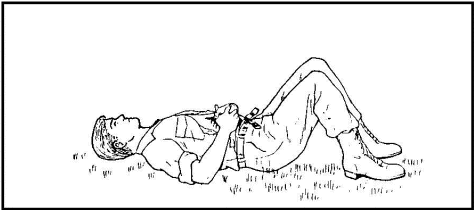
LESSON 9
PERFORM FIRST AID FOR AN OPEN ABDOMINAL WOUND
(TASK 081-831-1025)
TASK:
Identify the procedures for administering first aid to a casualty with an open abdominal wound.
CONDITIONS:
Given multiple-choice examination items pertaining to abdominal wounds.
STANDARD:
Score 70 or more points on a 100-point comprehensive examination.
REFERENCES:
STP
21-1-SMCT, Soldiers Manual of Common Tasks: Skill Level 1.
FM
21-11, First Aid for Soldiers.
NOTE:Some of the task titles and information have changed and are not reflected in FM 21-11 and STP 21-1-SMCT. Refer to the Army Training Support Center, Common Core Task internet site at: http://www.atsc.army.mil/dld/comcor/comcore.htm for up-to-date task information.
The body's abdominal cavity contains organs such as the stomach, small intestine, large intestine, liver, kidneys, and spleen. Several large arteries and veins are also located in the abdominal cavity. An object that punctures the muscular abdominal wall can injure one or more organs, cause severe bleeding, and cause infection which could spread to the organs within the cavity.
An open abdominal wound can be caused by the muscular abdominal wall being penetrated by a bullet, by a stab from a knife, by an object blown from an explosion, or by falling on a sharp object.
9-2. POSITION A CASUALTY WITH AN OPEN ABDOMINAL WOUND
FIGURE 9-1. CASUALTY IN KNEES-UP POSITION
9-3. DRESS AN OPEN ABDOMINAL WOUND
Locate Abdominal Wound(s)
Check the casualty's abdominal region for wounds. If more than one open abdominal wound is found, treat the more serious wound (largest, most blood loss, etc.) first.
Expose the Wound
| WARNING | |
| If you are in a chemical environment, dress the wound without exposing the wound. | |
Expose the area around the open abdominal wound by removing, cutting, or tearing the clothing covering the wound. If clothing is stuck to the wound, do not try to remove the stuck clothing as this may cause additional pain and injury. Cut or tear around the stuck clothing. Do not try to probe, clean, or remove foreign objects from the wound.
Position Dislodged Organs, If Applicable
Place Dressing Over Wound
| WARNING | |
| If a foreign object is protruding from the wound, do not attempt to remove the object. Improvise bulky dressings from the cleanest material available and build up the area around the object in order to stabilize the object. Secure the dressing with improvised bandages. | |
Open the casualty's field dressing and place the white side of the dressing over the wound and any protruding organs. If the field dressing is too small to cover the wound and any protruding organs or if the dressing is not available, use the cleanest materials available as a dressing. Clothing, part of a blanket, or similar materials may be used.
Secure the Dressing
Hold the dressing with one hand to keep it from slipping.
Grasp one tail and slide it under the casualty.
Reach down on the other side of the casualty, grasp the tail under the casualty, and pull.
Bring the tail up the casualty's side, over the dressing, and to the other side.
Wrap the other tail in the opposite direction (down the side, under the back, and up the side).
Tie the tails in a nonslip knot on the casualty's side away from the wound. Do not tie the knots over the wound site.
FIGURE 9-2. DRESSING AN OPEN ABDOMINAL WOUND
Dress Other Abdominal Wound(s)
If other abdominal wounds are present (both entry and exit wounds are present, for example), dress and bandage the wounds.
Reinforce Dressings
| CAUTION: Do not tie any knots over the wound site. |
9-4. MONITOR A CASUALTY WITH AN OPEN ABDOMINAL WOUND
Keep the casualty in the knees-up position.
Get medical help for the casualty as soon as possible. Buddy-aid methods cannot control internal bleeding (blood flowing into the abdominal cavity instead of flowing out of the wound). The risks of serious infection and damage to internal organs are also present. If possible, send someone else to get medical help while you treat the wound.
| CAUTION: Do not give the casualty anything to eat or drink. If the casualty complains of thirst, moisten his lips with a damp cloth. |
Be ready to administer rescue breathing should it become necessary.
If you must leave the casualty, tell him to stay on his back and keep his knees up.